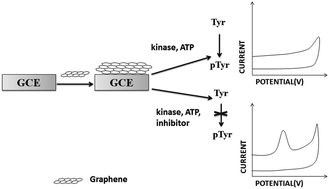Graphene based electrochemical biosensor for label-free measurement of the activity and inhibition of protein tyrosine kinase
Abstract
In this paper, we report a simple, ultrasensitive and label-free method to evaluate the activity of protein tyrosine (Tyr) kinase based on the electrochemical signal of Tyr residues at a graphene modified glassy carbon electrode. It was found that graphene could enhance the electrochemical response of Tyr through electrocatalytic oxidation reaction. After phosphorylation by kinase, the phosphorylated Tyr (pTyr) is electro-inactive and the electrochemical signal is reduced. Therefore, the electrochemical response of Tyr residues in peptides can be used as a signal reporter to assay kinase activity. In this study, using Src-catalyzed Tyr-phosphorylation as a model, the activity of kinase can be evaluated with a linear range from 0.26 to 33.79 nM and an extraordinarily low detection limit of 0.087 nM. Moreover, this electrochemical biosensor can also be utilized for monitoring the inhibition of kinase using 4-amino-5-(4-chlorophenyl)-7-(tert-butyl) pyrazolo [3,4-d] pyrimidine, a small molecule inhibitor. On the basis of the inhibitor concentration dependent Tyr oxidation signal, the IC50 value was estimated to be 99 nM.


 Please wait while we load your content...
Please wait while we load your content...